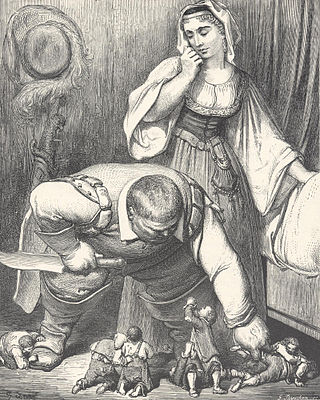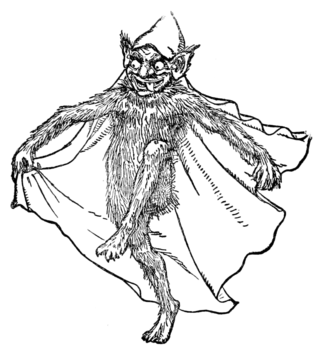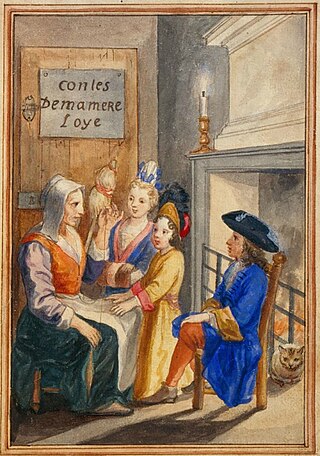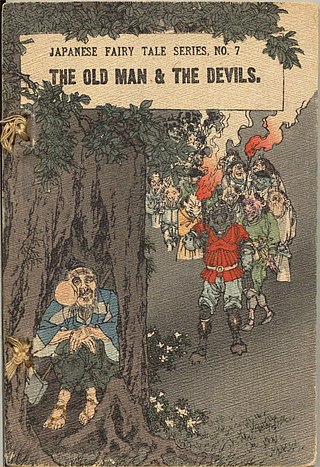
A fairy tale is a short story that belongs to the folklore genre. Such stories typically feature magic, enchantments, and mythical or fanciful beings. In most cultures, there is no clear line separating myth from folk or fairy tale; all these together form the literature of preliterate societies. Fairy tales may be distinguished from other folk narratives such as legends and explicit moral tales, including beast fables. Prevalent elements include dwarfs, dragons, elves, fairies, giants, gnomes, goblins, griffins, mermaids, talking animals, trolls, unicorns, monsters, witches, wizards, magic, and enchantments.
"Cinderella", or "The Little Glass Slipper", is a folk tale with thousands of variants that are told throughout the world. The protagonist is a young girl living in forsaken circumstances that are suddenly changed to remarkable fortune, with her ascension to the throne via marriage. The story of Rhodopis, recounted by the Greek geographer Strabo sometime between 7 BCE and CE 23, about a Greek slave girl who marries the king of Egypt, is usually considered to be the earliest known variant of the Cinderella story.

Faust is the protagonist of a classic German legend based on the historical Johann Georg Faust.

Charles Perrault was a French author and member of the Académie Française. He laid the foundations for a new literary genre, the fairy tale, with his works derived from earlier folk tales, published in his 1697 book Histoires ou contes du temps passé. The best known of his tales include "Le Petit Chaperon Rouge", "Cendrillon" ("Cinderella"), "Le Maître chat ou le Chat botté", "La Belle au bois dormant", and "Barbe Bleue" ("Bluebeard").

'Puss' is a character in the fairy tale "The Master Cat, or Puss in Boots" by Charles Perrault. The tale was published in 1697 in his Histoires ou Contes du temps passé. The tale of a cat helping an impoverished master attain wealth through its trickery is known in hundreds of variants.
Japanese folktales are an important cultural aspect of Japan. In commonplace usage, they signify a certain set of well-known classic tales, with a vague distinction of whether they fit the rigorous definition of "folktale" or not among various types of folklore. The admixed impostors are literate written pieces, dating back to the Muromachi period or even earlier times in the Middle Ages. These would not normally qualify for the English description "folktales".

"Sleeping Beauty", also titled in English as The Sleeping Beauty in the Woods, is a fairy tale about a princess cursed by an evil fairy to sleep for a hundred years before being awakened by a handsome prince. A good fairy, knowing the princess would be frightened if alone when she wakes, uses her wand to put every living person and animal in the palace and forest asleep, to awaken when the princess does.

Marcel Aymé was a French novelist and playwright, who also wrote screenplays and works for children.

Hop-o'-My-Thumb (Hop-on-My-Thumb), or Hop o' My Thumb, also known as Little Thumbling, Little Thumb, or Little Poucet, is one of the eight fairytales published by Charles Perrault in Histoires ou Contes du temps passé (1697), now world-renowned. It is Aarne-Thompson type 327B. The small boy defeats the ogre. This type of fairytale, in the French oral tradition, is often combined with motifs from the type 327A, similar to Hansel and Gretel; one such tale is The Lost Children.
French folklore encompasses the fables, folklore, fairy tales and legends of the French people.
Puss in Boots is a 1922 film directed by Walt Disney. The film was based on the book by Charles Perrault.
Bearskin is a French literary fairy tale by Marie-Madeleine de Lubert. It was included in her revised edition, published in 1753, of Henriette-Julie de Murat's last novel, Les Lutins du château de Kernosy, which is why it is often attributed to Madame Henriette-Julie de Murat.

A goblin is a small, grotesque, monstrous creature that appears in the folklore of multiple European cultures. First attested in stories from the Middle Ages, they are ascribed conflicting abilities, temperaments, and appearances depending on the story and country of origin, ranging from mischievous household spirits to malicious, bestial thieves. They often have magical abilities similar to a fairy or demon, such as the ability to shapeshift.

"Puss in Boots" is a European fairy tale about an anthropomorphic cat who uses trickery and deceit to gain power, wealth, and the hand in marriage of a princess for his penniless and low-born master.

Histoires ou contes du temps passé, avec des moralités or Contes de ma mère l'Oye is a collection of literary fairy tales written by Charles Perrault, published in Paris in 1697. The work became popular because it was written at a time when fairy tales were fashionable amongst aristocrats in Parisian literary salons. Perrault wrote the work when he retired from court as secretary to Jean-Baptiste Colbert, minister to Louis XIV of France. Colbert's death may have forced Perrault's retirement, at which point he turned to writing. Scholars have debated as to the origin of his tales and whether they are original literary fairy tales modified from commonly known stories, or based on stories written by earlier medieval writers such as Boccaccio.
Fairer-than-a-Fairy or More Beautiful Than Fairy is a literary fairy tale by Charlotte-Rose de Caumont de La Force in 1698.

"Kobutori Jiisan" translated directly as "Lump-Taken Old Man" is a Japanese Folktale about an old man who had his lump taken or removed by demons after joining a party of demons (oni) celebrating and dancing in the night.
Urikohime, Uriko-hime or Uriko Hime is a Japanese folktale about a girl that is born out of a melon, adopted by a family and replaced by a creature named Amanojaku.
The Fire Boy is a Japanese folktale collected by scholar Seki Keigo. It tells of a boy expelled from home to another realm and, thanks to the efforts of a faithful horse, marries a lord's daughter.
The Golden Eggplant is a Japanese folktale, published by scholar Seki Keigo in Folktales of Japan. Scholars relate it to tale type ATU 707, "The Three Golden Children", of the international Aarne-Thompson-Uther Index.











